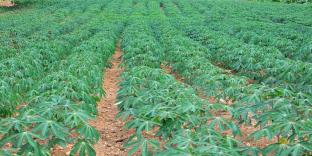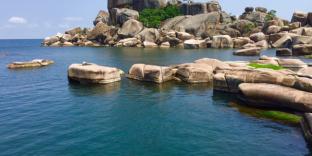Natural Resources
Natural Resource Department
The department is comprised of three sectors; Environment and wetlands, Forestry, and Lands sector.
The Department is charged with the responsibility of managing and protecting the environment, as well as other natural resources, and promoting their sustainable use for the social and economic benefits of the district population.
The department has one Senior Environment Officer (also acting District Natural Resources Officer), 1 district Environment Officer, One Forestry Officer, one district Staff Surveyor, physical planner, senior lands officer, assistant forest officer and 2 forest Rangers.
The district is endowed with a variety of natural resources which include water resources, land, forestry resources, wetland resources and mineral resources. However most of these resources have been heavily encroached upon for both subsistence and commercial uses hence highly degraded. The major minerals mined are Sand and Gold.
Mission
To protect the environment and promote sustainable utilization of the natural resources for social and economic benefits of the communities.
Overall objective
To promote land use activities aimed at sustainable utilization and management of the district environment and natural resources for socio-economic development.
Land sector.
The district has a total area of 3,041.9 Sq.Km, of which 1,062 is dry land and the rest therefore is covered by water bodies. The land surface is characterized by gentle undulating hills with few higher residual features. A narrow and generally higher accentuated relief to the south forms a watershed between Lake Victoria drainage and the northern drainage.
The district has a district land board which manages land matters with an ultimate aim of improving the livelihoods of the population by reducing poverty levels basing on the fact that land is a basic factor of production.
Most of the land in the district is under unregistered customary ownership with an increasing number of leaseholds and freeholds in the Namayingo town council and Buyinja Sub County. The main land use is agriculture, but the use depends on ownership, tenure, and customs.
Environment sector
Environment means the physical factors of the surroundings of the human beings including land, water, atmosphere, climate, sound, odour, the biological factors of animals and plants and the social factors of aesthetics and includes both the natural and the built environment.
The sector is composed of two sub sectors; the environment sub sector and the wetlands sub sector. Namayingo district is endowed with a human friendly environment, however, due to population pressure and the bid of the population to provide a livelihood is negatively impacting on the environment.
Forestry sector
A total of 546 hectares of the district land is under central forest reserves though these have been highly encroached on and/or cleared for firewood, charcoal, building poles, timber, farming and other non-timber products.
There is a general reduction of natural tree cover in the district arising from excessive harvesting of wood biomass.
Some of the tree species like Muvule, Cordia sp. and Albizia are facing extinction due to high demand for quality timber, for furniture and building. A good number of people have however picked up enthusiasm in tree planting.
Although the majority of people are interested in tree planting, the major limitationsare lack of adequate land, and inadequate funds to procure seedlings. However the forestry sector is encouraging people to adopt agro forestry.
It is also noted that some of the sub counties have taken up tree planting in their annual work plans and budgets. The sector encourages all sub counties to follow suit.
STATE OF THE NATURAL RESOURCES IN THE DISTRICT
Land Resources
The main land use is agriculture, but the use depends on ownership, tenure, and customs.
Forests are mainly cleared for purposes of agriculture and charcoal burning; gazetted forest reserves have not been spared in this regard.
Wetlands have been under considerable pressure from agricultural conversion resulting in excessive draining of these fragile ecosystems. Wetlands have been mostly encroached on for rice cultivation. The productivity in the wetlands has been declining gradually over the years. One of the main environmental concerns is that while substantial fields of crops are realisable after the initial clearance, later they decline due to oxidation, acidification and shrinkage in the reclaimed areas.
As a result, over time, the economic and ecological value of a conserved ecosystem is often greater than the converted wetland or forest. The pressures behind ecosystem fragility are; deforestation, poor farming methods, Land tenure system (majorly customary). These pressures lead to loss of topsoil and eventually loss of the land's ability to support plant and animal life (human life inclusive).
Forest degradation
Rapid deforestation and degradation of forest reserves are some of the adverse impacts resulting from lack of management of forests. The main pressures behind deforestation are;
- Increased demand for forest land for cultivation
- Increased demand for forest products like fuel wood, timber, poles, charcoal etc.
- Poverty
- Breakdown of law or weak enforcement
The high rate of deforestation has also resulted in bare hills with no trees or grass for example Syabona hill.
Water Resources
The geological formation of the district coupled with a favourable geomorphology has contributed to the great water resources endowments enjoyed in the district. The district has a wide diversity of water resources in form of surface water e.g. fresh water bodies, swamps, and streams; ground water resources and water in form of precipitation. These water sources have been exploited in various ways.
Wetlands
There has been a lot of encroachment on the wetlands for crop cultivation and unless the trend is reversed, the district’s wetlands will be completely destroyed in future. All the major wetlands in the district can be categorized as papyrus swamps, swamp forest, and lake edge wetlands. The soil found under these wetlands is quite different from the up land soils due to the condition underlying their formation. Wetlands are used in various ways, which include livestock grazing, building materials, agriculture, fishing, energy sources etc. It is evident that they are on high demand thus liable to being over-utilized. The pressures leading to over utilization are: population pressure, demand for wood fuel, over cultivation and lack of guidelines in the community regarding use and management of the resource.
Despite the enormous contribution the wetlands provide to the wellbeing of the People of the district, they are under increasing threats and the major pressures are; conversion to rice cultivation, brick making, sand mining, seasonal fires, over harvesting an grazing of animals. Therefore wetlands are being reclaimed at a high rate. This implies loss of biodiversity and habitat for a variety of wildlife species. Environmental education along with rules and regulation backed with policy guidelines on reclaiming wetlands will do quite a lot to save the situation.
SWOT ANALYSIS
Strength
- There is good political will towards management of the environment and natural resources(ENR)
- There are strict laws and regulations that govern environmental management
Weakness
- Inadequate funding to the department
- Minimum support from the line ministry, NEMA and Forest Support Services Division
- Lack of up to date data on the natural resources within the district
- Poor management and utilization of the natural resources by communities
- Lack of bye-laws and ordinances on Natural Resources management within the district
Opportunities
- Existence of a number of national laws, policies and regulation on ENR management.
- Existence of synergies with civil society organizations and other department
Threats
- Rampant deforestation and vegetation clearance, mainly for cultivation purposes
- Uncontrolled and unregulated encroachment on natural resources like wetlands and forests Low levels of awareness on ENR management in communities.
- Increased pressure on the natural resources as result of the high population growth rate
- Discriminative land tenure categories to the vulnerable and marginalized communities.



